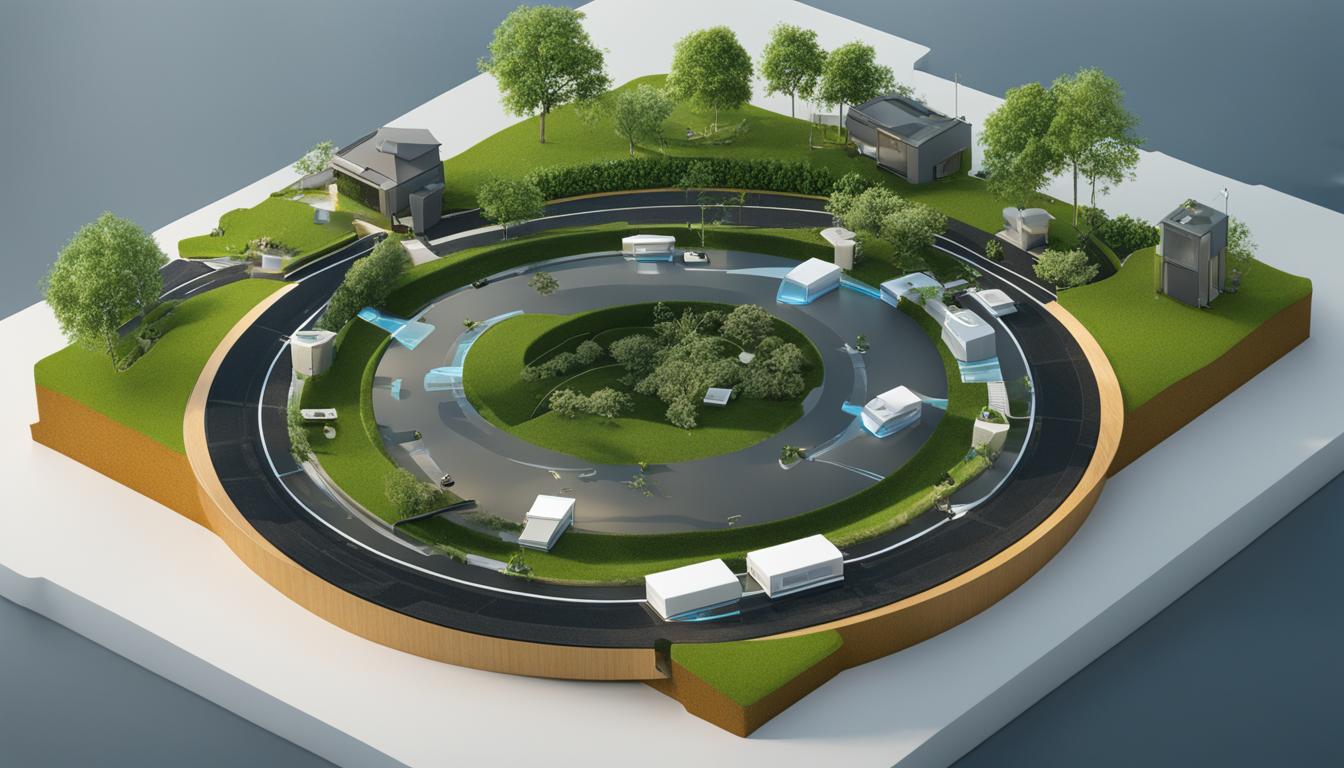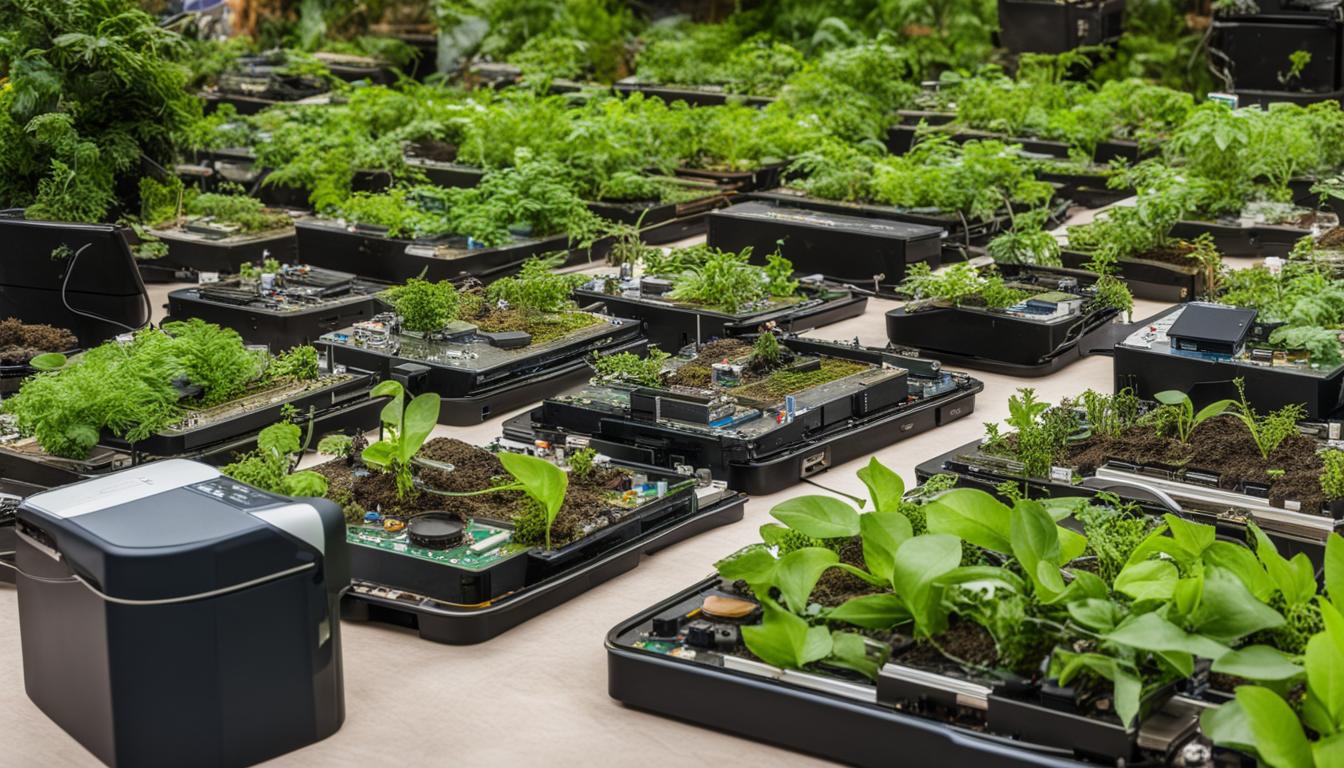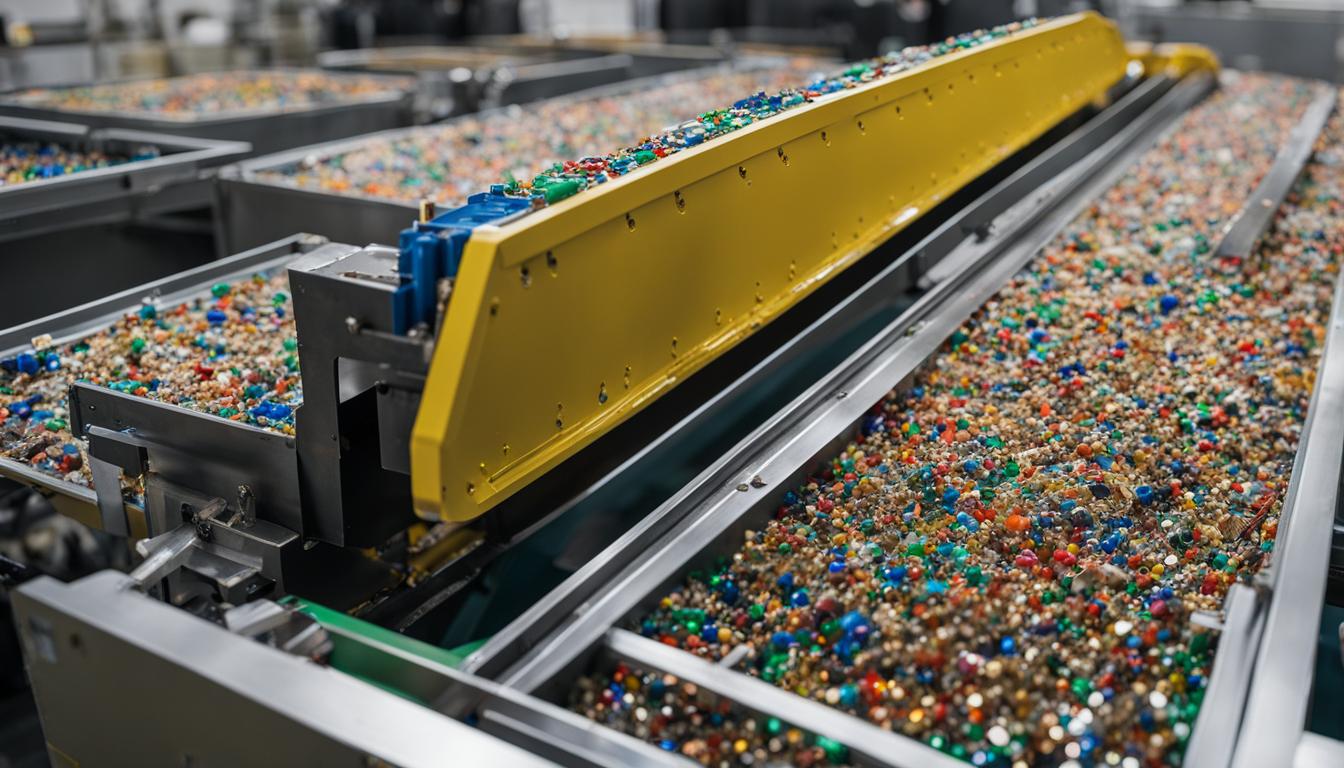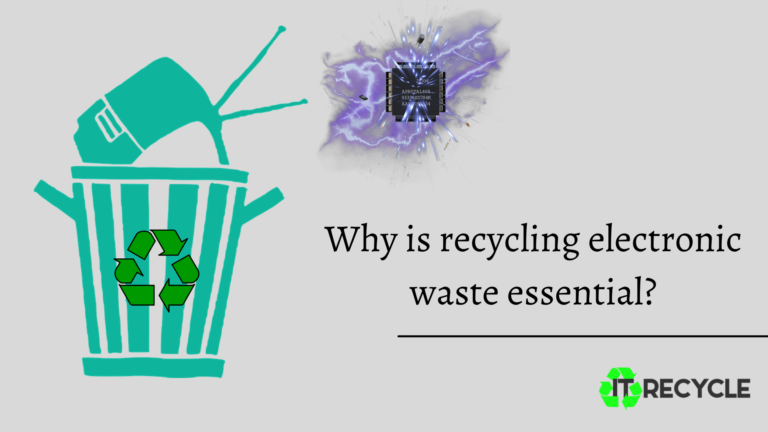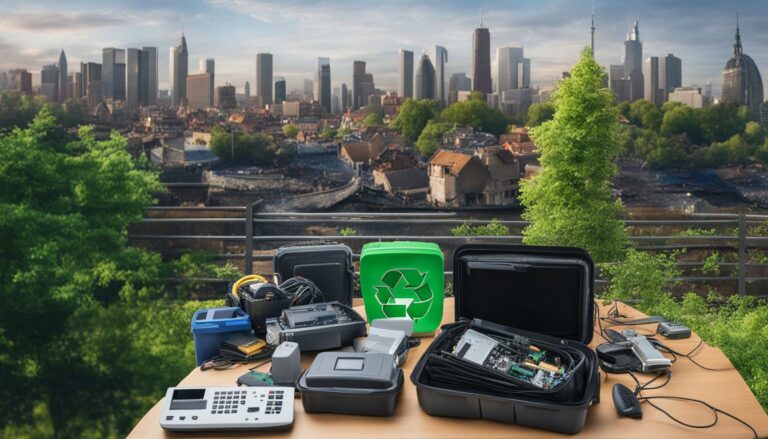Planning for the End-of-Life: Purchasing with Recycling in Mind
The concept of a circular economy, where everything is reused and waste doesn’t exist, is gaining traction. However, achieving a more sustainable way of satisfying our material wants requires a complete reimagining of how we live our lives. The current linear production system contributes to the immense amount of waste generated each year, with only a small percentage being recycled or reused. To address this issue, businesses and individuals need to adopt a strategic approach to end-of-life IT purchasing, considering the principles of sustainable IT procurement and proper IT asset disposal.
Key Takeaways:
- Embracing a circular economy can help minimize waste and promote reuse.
- End-of-life IT asset disposal is crucial for minimizing the environmental impact of e-waste.
- Sustainable IT procurement strategies prioritize environmental responsibility.
- Proper end-of-life IT purchasing reduces resource extraction and promotes resource recovery.
- Individuals play a role in implementing sustainable practices in everyday life.
Understanding the Circular Economy
The concept of a circular economy is at the forefront of sustainable practices, aiming to redefine how we produce, consume, and dispose of products and services. It emphasizes the importance of maximizing the lifespan of resources and promoting reuse, repair, and recycling. Green IT purchasing and effective lifecycle management are crucial elements of embracing the principles of the circular economy in the realm of technology.
Lifecycle management involves considering the entire lifespan of IT equipment, from procurement to end-of-life disposal. This holistic approach ensures that the environmental impact of IT assets is minimized, and their useful life is extended. By prioritizing energy-efficient and environmentally friendly options during the procurement process, organizations can contribute to the circular economy and reduce waste generation.
“Adopting sustainable IT practices not only benefits the environment but also presents a compelling business case. Businesses can demonstrate their commitment to environmental responsibility and corporate sustainability, enhancing their reputation and attracting eco-conscious customers.”
Implementing sustainable IT procurement strategies aligns with the principles of the circular economy. Organizations can seek suppliers that adhere to sustainable manufacturing practices and offer take-back programs for end-of-life equipment. These practices not only contribute to minimizing e-waste but also ensure the recovery of valuable materials, reducing the need for resource extraction.
| Benefits of Embracing the Circular Economy in IT Purchasing |
|---|
| Reduces environmental impact |
| Minimizes waste generation |
| Promotes resource conservation |
| Enhances corporate sustainability |
| Contributes to a more sustainable future |
The Importance of End-of-Life IT Asset Disposal
Proper end-of-life IT asset disposal plays a crucial role in minimizing the environmental impact of electronic waste (e-waste). E-waste contains hazardous materials that can harm the environment if not handled and disposed of properly. By recycling IT equipment, valuable materials can be recovered and reused, reducing the need for virgin resources and lowering the overall carbon footprint.
According to the Environmental Protection Agency (EPA), in the United Kingdom alone, around 2 million tons of electronic waste are discarded each year, with only a fraction being properly recycled. This highlights the pressing need for responsible e-waste management to mitigate the detrimental effects on the environment.
Adopting sustainable practices for IT equipment recycling helps protect natural resources and prevents hazardous substances from polluting the soil and water. Additionally, it contributes to corporate sustainability efforts, demonstrating a commitment to environmental responsibility and the principles of the circular economy. By responsibly disposing of end-of-life IT assets, organizations can contribute to a greener future and set an example for others to follow.
Proper end-of-life IT asset disposal is not just an environmental responsibility; it is also an opportunity for businesses to showcase their commitment to sustainability. By embracing recycling practices and implementing effective e-waste management, organizations can enhance their reputation and attract environmentally-conscious consumers.
In conclusion, proper end-of-life IT asset disposal is crucial for minimizing the environmental impact of electronic waste. By recycling IT equipment, valuable materials can be recovered, reducing the need for virgin resources and contributing to the circular economy. Responsible e-waste management not only protects the environment but also demonstrates a commitment to sustainability and corporate social responsibility. It is imperative for businesses and individuals alike to prioritize IT equipment recycling and embrace their role in building a more sustainable future.
| Impact of E-waste | Environmental Responsibility |
|---|---|
| E-waste contains hazardous materials that can harm the environment if not disposed of properly. | Proper end-of-life IT asset disposal demonstrates a commitment to environmental responsibility. |
| Only a fraction of electronic waste is properly recycled, leading to pollution and resource depletion. | Recycling IT equipment reduces the need for virgin resources and minimizes waste generation. |
| E-waste can pollute soil and water, impacting ecosystems and human health. | Responsible e-waste management helps protect natural resources and prevent pollution. |
Strategies for Sustainable IT Procurement
Implementing sustainable practices in IT procurement is essential for organizations looking to contribute to the circular economy and reduce their environmental impact. By considering the principles of sustainable IT procurement, businesses can prioritize green IT purchasing and minimize waste generation throughout the lifecycle of IT equipment.
One strategy for sustainable IT procurement is to assess the environmental impact of IT products and services. This involves evaluating the energy efficiency of devices, as well as considering the use of environmentally friendly materials and manufacturing processes. By selecting energy-efficient options and products made from recycled or sustainable materials, businesses can significantly reduce their carbon footprint.
Another key strategy is to partner with suppliers that prioritize sustainability. This includes seeking out suppliers that adhere to sustainable manufacturing practices and have established take-back programs for end-of-life equipment. By working with suppliers who share the same environmental values, businesses can ensure a more sustainable supply chain and contribute to the circular economy.
Benefits of Sustainable IT Procurement:
- Minimizes waste generation
- Reduces carbon footprint
- Prioritizes energy efficiency
- Promotes the use of sustainable materials
- Contributes to the circular economy
Overall, implementing sustainable IT procurement practices is not only beneficial for the environment but also for businesses themselves. By embracing the principles of the circular economy and green IT purchasing, organizations can reduce e-waste, conserve valuable resources, and demonstrate their commitment to environmental responsibility.
| Key Strategies for Sustainable IT Procurement | Benefits |
|---|---|
| Assessing environmental impact of IT products and services | Minimizes waste generation and reduces carbon footprint |
| Partnering with suppliers that prioritize sustainability | Promotes the use of sustainable materials and contributes to the circular economy |
By adopting these strategies and incorporating sustainability into IT procurement practices, businesses can play a vital role in creating a more sustainable future.
Benefits of End-of-Life IT Purchasing with Recycling in Mind
Adopting an end-of-life IT purchasing approach that prioritizes recycling and sustainability offers numerous benefits. It reduces the environmental impact of e-waste by ensuring proper disposal and recycling, promoting the recovery of valuable materials and reducing the need for resource extraction. End-of-life IT purchasing also aligns with the principles of the circular economy, contributing to a more sustainable and responsible business model. Furthermore, it allows organizations to demonstrate their commitment to environmental responsibility and corporate sustainability.
By incorporating end-of-life IT purchasing with recycling in mind, businesses can minimize the negative impacts associated with electronic waste. Valuable materials, such as precious metals and rare elements, can be recovered through recycling processes instead of being discarded in landfill sites. This not only conserves natural resources but also reduces the energy and water consumption associated with extracting and processing virgin materials. Additionally, recycling IT equipment reduces greenhouse gas emissions that would be generated during the production of new equipment.
Another benefit of end-of-life IT purchasing with recycling in mind is the reduction of electronic waste pollution. The improper disposal of IT equipment can lead to toxins and hazardous materials seeping into the environment, contaminating soil and water sources. By prioritizing proper recycling and disposal methods, businesses can mitigate these harmful effects, ensuring a healthier and safer environment for future generations. Moreover, organizations can comply with regulatory requirements and demonstrate their commitment to environmental responsibility, enhancing their reputation and attracting environmentally conscious customers.
| Benefits of End-of-Life IT Purchasing with Recycling in Mind |
|---|
| Reduces environmental impact of e-waste |
| Promotes recovery of valuable materials |
| Aligns with circular economy principles |
| Demonstrates commitment to environmental responsibility |
| Minimizes negative impacts of electronic waste |
| Conserves natural resources |
| Reduces energy and water consumption |
| Reduces greenhouse gas emissions |
| Prevents electronic waste pollution |
| Enhances reputation and attracts environmentally conscious customers |
Implementing Sustainable Practices in Everyday Life
Embracing the principles of the circular economy and sustainable IT practices in everyday life is essential for individuals to contribute to a more sustainable future. By adopting a “reduce, reuse, repair, refurbish, and recycle” mindset when it comes to IT equipment and other possessions, we can minimize waste generation and maximize resource utilization.
Extending the lifespan of products through repair and refurbishment is a simple yet effective way to reduce our environmental impact. Instead of discarding IT equipment when it breaks or becomes outdated, consider repairing it or finding someone who can. By doing so, we not only reduce waste but also conserve the valuable resources used in manufacturing these devices. It’s a win-win situation for both the environment and our wallets.
When it comes time to dispose of IT equipment that is no longer usable, recycling becomes crucial. Recycling IT equipment ensures that valuable materials can be recovered and reused, reducing the need for resource extraction and minimizing the environmental impact of e-waste. Many local communities and electronics retailers offer recycling programs for electronics, making it easier than ever to dispose of IT equipment responsibly. By taking advantage of these programs, we can play our part in protecting the environment and supporting the circular economy.
“The best way to predict the future is to create it.” – Peter Drucker
The Benefits of Sustainable IT Practices
Implementing sustainable practices in everyday life has a multitude of benefits. By adopting a circular economy mindset and prioritizing IT equipment recycling, we contribute to the preservation of valuable resources and the reduction of waste. This not only protects the environment but also helps to create a more sustainable and responsible future for all.
| Benefits of Sustainable IT Practices | |
|---|---|
| Reduces environmental impact | By minimizing waste generation and promoting resource conservation. |
| Supports the circular economy | By aligning with the principles of reusing, repairing, and recycling. |
| Demonstrates environmental responsibility | By actively participating in sustainable practices and setting an example for others. |
| Contributes to a more sustainable future | By protecting valuable resources and reducing the overall environmental impact. |
Implementing sustainable practices in everyday life may seem like a small step, but it has a significant impact when multiplied by the actions of individuals around the world. By taking responsibility for our IT equipment and making conscious choices to reduce, reuse, repair, refurbish, and recycle, we become part of a larger movement towards a more sustainable and environmentally responsible future.
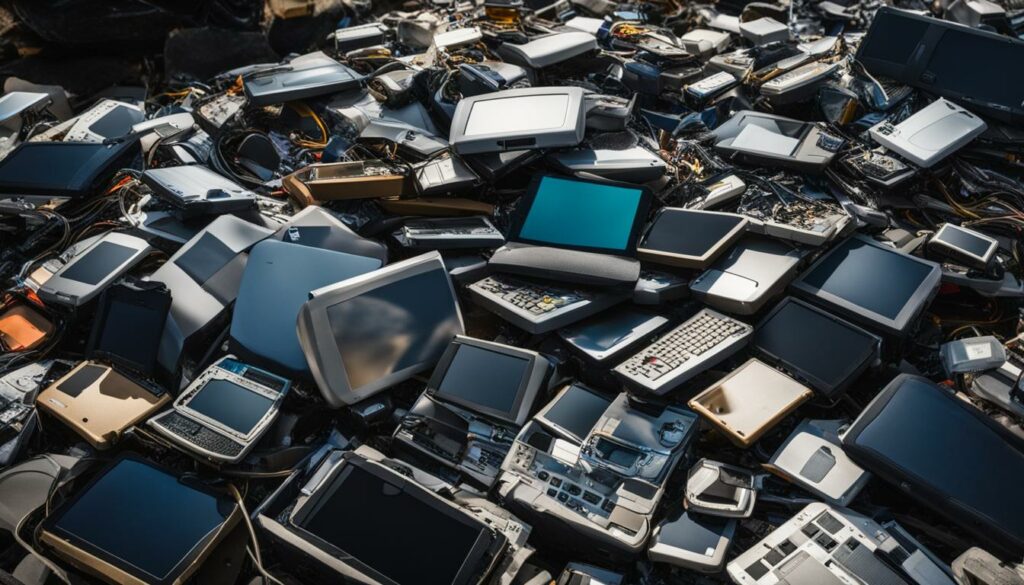
Conclusion
Planning for the end-of-life of IT purchasing with recycling in mind is a strategic approach that aligns with the principles of the circular economy and promotes sustainable practices. Proper IT asset disposal, incorporating sustainable IT procurement strategies and embracing the principles of the circular economy, all contribute to minimizing waste generation and reducing the environmental impact of IT equipment.
By prioritising environmental responsibility in the end-of-life stage of IT equipment, businesses and individuals can contribute to a more sustainable future and protect valuable resources. Implementing these practices not only helps to reduce e-waste but also promotes the recovery of valuable materials through recycling, reducing the need for resource extraction.
Adopting a circular economy mindset in IT purchasing and disposal not only benefits the environment but also reflects a sense of environmental responsibility. It demonstrates a commitment to a sustainable business model and showcases a dedication to corporate sustainability. By embracing the circular economy and sustainable IT practices, individuals can contribute to a more sustainable future and play a vital role in protecting the environment.
FAQ
What is the circular economy?
The circular economy is a concept that focuses on reworking the way we produce, consume, and dispose of products and services. It aims to maximize resource utilization by promoting reuse, repair, and recycling.
Why is end-of-life IT asset disposal important?
Proper end-of-life IT asset disposal is crucial for minimizing the environmental impact of electronic waste (e-waste). It ensures that hazardous materials are disposed of correctly and that valuable resources can be recovered and reused.
What are some strategies for sustainable IT procurement?
Strategies for sustainable IT procurement include considering the environmental impact of IT products throughout their lifecycle, prioritizing energy-efficient options, and seeking suppliers that adhere to sustainable manufacturing practices.
What are the benefits of end-of-life IT purchasing with recycling in mind?
End-of-life IT purchasing with recycling in mind reduces the environmental impact of e-waste, promotes resource recovery, and aligns with the principles of the circular economy. It also allows businesses to demonstrate their commitment to environmental responsibility and corporate sustainability.
How can individuals implement sustainable practices in everyday life?
Individuals can adopt a “reduce, reuse, repair, refurbish, and recycle” mindset when it comes to IT equipment and other possessions. By extending the lifespan of products through repair and refurbishment and recycling them when no longer usable, individuals can minimize waste generation and maximize resource utilization.
Source Links
- https://www.netzeronation.scot/blog/circular-economy-alternative-our-throw-away-culture
- https://www.newscientist.com/article/mg25333730-800-the-end-of-waste-the-grand-plan-to-build-a-truly-circular-economy/
- https://consult.defra.gov.uk/waste-and-recycling/waste-prevention-programme-for-england-2021/supporting_documents/Waste Prevention Programme for England consultation document.pdf


